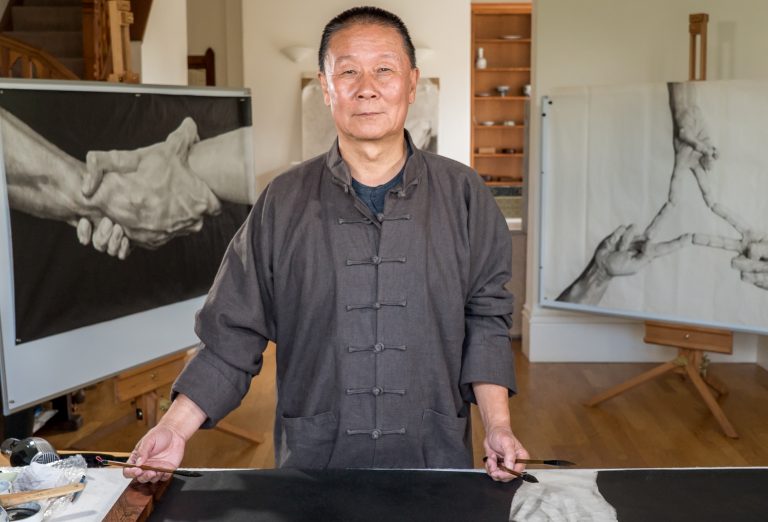A special feature on Chinese artist Qiu Leilei’s original voice in Western contemporary art
A dynamic social media presence and busy calendar of networking events are usually key components of a successful artistic career these days. However, British Chinese creative practitioner Qu Leilei never received the memo during his journey to world-renowned leading contemporary artist. His humility, preference for solitude over social events and steadfast focus on his art make him an enigma in an age where popular culture and the internet have high expectations of artists to share their hearts and personal lives beyond their art. I had the rare privilege to sit down with Qu Leilei to learn about the art of living and living artfully.
Qu Leilei has enjoyed a private and unassuming lifestyle in the UK for nearly 40 years. His preference for simplicity allowed him to focus on his art without getting distracted by superficial noise of modern life. His masterpieces have gained broad recognition and widespread acclaim within the arts and culture industry in the UK and abroad.
Born in the early 1950s, Qu Leilei showed a clear passion for sketching and painting from a young age and this was cultivated by his artistic parents. As a young boy, he was sent to learn the craft from a renowned master, Tan Wucun. He studied traditional Chinese painting and calligraphy. Just a few years later, his career path was changed by external circumstances. Like many young adults during the Cultural Revolution, Qu Leilei was sent to the countryside to work as a farmer after graduating high school. He also worked as a healthcare worker, providing basic medical care before enlisting in the army. Following the completion of his national service, he worked as a lighting technician and eventually a documentary film producer for state television. These diverse career experiences spanned over a decade, but his artistic aspirations remained undiminished.

During the late 1970s to early 1980s, Qu Leilei collaborated with other young artists, poets, and musicians in Beijing to produce the “Xing Xing Art Show”. The aim of this exhibition was to showcase “how they viewed the world in their own eyes and expressed their thoughts and feelings using their own brushes”. Qu Leilei was the youngest participant and gained notable prominence, which further strengthened his conviction that his life purpose was to engage in artistic creation. He applied to the Central Academy of Fine Arts, the most prestigious institute of art education in China, and met the admission criteria. However, due to various reasons, he was unable to enrol. This setback helped Qu Leilei realise he needed to broaden his horizons and venture beyond the country’s borders to the more open and free-spirited Western societies to pursue his artistic dreams.
In 1985, Qu Leilei bid farewell to his hometown and set off for the UK with just thirty dollars and a box of paintings. Although the fine details of how he would achieve his artistic goals were not clear, his determination was resolute, and he was prepared to endure numerous hardships to get there. He sketched and painted portraits of passers-by on the street throughout the year, no matter how cold, hot, wet or windy it was. He travelled through stormy weather to teach Chinese calligraphy and painting classes and undertook menial jobs like ironing in a launderette and dishwashing in a restaurant kitchen to earn money. His relentless work ethic was fuelled by his artistic ambitions, and he continued to paint and create art daily throughout this period.

In 1986, Qu Leilei was successfully awarded a place to study at the London Central College of Art, where he trained under the renowned British painter Cecil Collins and mastered his skills in Western painting techniques. After graduating, empowered by his exposure to Western art, he embarked on a professional career as an artist.
An important part of Qu Leilei’s creative process is the reading, self-reflection, and philosophical contemplation he undertakes prior to putting brush to paper. Each series of art pieces has taken approximately five years to complete. Titles include “Ink and Water in Britain: Application of Light and Shadow to Chinese Painting,” “Facing the Future,” “Every Person’s Life is an Epic,” and “Empire,” amongst others. The underlying themes are extremely varied and include the perception of humanity, exploration of moral values, expression of dignity and concepts of innovation in traditional Chinese painting. Qu Leilei’s use of Chinese techniques in Western surrealism methods have defined his status as a legendary contemporary artist. His art is a striking homage to human history and culture beyond geographical borders. His work is part of permanent collections in the British Museum, the Victoria and Albert Museum, Palazzo Reale Milano and the Ashmolean Museum of Art and Archaeology, Oxford, a testament to his widespread critical and public success.

( Qu’s artwork Leifeng collected by British Museum )
During 2017-2018, the British Museum selected two 6-foot-long ink paintings for public display as part of their permanent collection due to the innovative techniques Qu Leilei used to create his unique vision. These two originated from two different thematic series of his work. “Lei Feng” (“Soldier”) is a piece from the “Empire” series. Qu Leilei used surrealist methods to integrate Lei Feng, a soldier in the 1960s who became a Chinese cultural icon known for his selflessness, with the Terracotta Army of Qin Emperor to explore the value of life and meaning of dignity in humanity through a modern eye, within the context of a 2000-year-old historical legacy. Qu Leilei depicted modern soldiers wearing the armour of the Terracotta army to denote how the threat of war is perpetual, transcending time in many forms. This blending of ancient war with conflict in modern society showcases Qu Leilei’s intelligence and creativity in painting art that examines history to understand the layers and issues of the society we live in now.
The second painting is “Journey”, which is part of the “Facing the Future” series. The artwork features two hands clasped together, to represent the unity of a couple, two countries, or even the world. He wanted to highlight the importance of unity in modern society to overcome the crises and challenges we currently face. By depicting two hands that remained united during the trials of time, Qu Leilei shares his vision of the future which is full of hope about the countless opportunities that could be achieved through unity and peace. He believes artists must create work that resonates with universal human values and a shared sense of belonging and destiny, to reach the world stage. His creativity is ground-breaking as he demonstrates how these core human beliefs and shared values can be found through exploring Chinese history and culture.

(Qu’s artwork Journey collected by British Museum)
The British Museum’s acquisition of these two art pieces further cemented Qu Leilei’s status as an innovative, pioneering contemporary artist. Traditional Chinese art comes from calligraphy; the marks connecting dots and lines convey ideas. Qu Leilei used traditional materials including ink, brush and xuan (rice) paper to explore new visual perspectives rather than denote direct thoughts. He adapted light and shadow techniques from his training in Western painting to highlight the modern soldier’s duty and responsibilities in the face of conflict that has existed in various forms throughout history. Similarly, in “Journey”, his use of light and shadow modelling emphasises the strength and vitality the clasped hands represent, a powerful beacon of hope for the future. This synthesis of Chinese and western art techniques expands the emotion and tension within each piece of art. His art truly feeds the soul, through the eyes.
In a career that has spanned nearly four decades, Qu Leilei has embraced the integration of Chinese art with Western art, using ink brush strokes with light and shadow techniques to create a new contemporary ink painting style. He has created a new era in Chinese ink painting with infinite potential for future generations to use Chinese art to chronicle history and the evolution of culture and society. His depictions of the human body for example are remarkable. Qu Leilei blends Eastern ideology with the artistic characteristics of the European Renaissance period, integrating Western techniques of light and shadow into strokes and lines of ink with meticulous attention to showcase the enchanting beauty of the human figure. “Goddess on a Flower Carpet” from his “Ink and Light – Aestheticism” series is one such masterpiece, a perfect harmony of delicate ink points and lines combined with light and shadow concepts. The way Chinese and western art techniques complement each other in a single artwork is a defining feature of Qu Leilei’s artistic style.

(Qu’s artwork “Goddess on a Flower Carpet”)
Qu Leilei’s work has been shown in museums and galleries across the globe in New York, Beijing. Paris, Tokyo, Milan, London and Hong Kong to name just a few. His art is coveted by institutions, corporations, and private individual collectors. Despite his many successes, Qu Leilei remains humble and sees himself first and foremost as a creative practitioner. He believes creating art is a way of living life and remains devoted to improving his artistic skills through continuous observation, study and reflection of the world around him. Ever conscious of the preciousness of time in modern society, Qu Leilei focuses his energy and attention in creating art day after day and year after year rather than undertake additional pursuits like some of his artist peers. He believes creating art shapes his character and will determine his legacy. His resolve to improve his art remains undiminished after all these years. From what we have seen so far, Qu Leilei will leave a powerful and original legacy in Chinese and Western art for the benefit of many generations to come.

Image from Top to down: Qu’s solo exhibitions in Milan Palace and Ashmolean Museum ( Oxford UK )
Editor: Joe Evans


